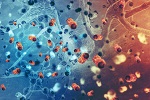
Among the best approaches to beating cancer is to use the body's own resources. Now one of these may just lead to a cancer cure. It aims to kill any cancer cell, anywhere in the body, with potentially no side effects.
Scientists at Northwestern University have discovered that all cells have a kill code that triggers cell suicide when they become cancerous. Today, chemotherapy is used in cancer to signal all dividing cells in the body to self-destruct which means even some healthy cells die. But researchers in this study found the code that tells only cancer cells to die.
The kill code is within molecules called si or mi-RNAs. These are small RNAs, or ribonucleic acids, that regulate how messenger RNAs are used. Messenger RNAs come from the DNA and are vital especially in the production of proteins.To find the kill code, the study looked at sequences of just six nucleotides in mi-RNAs.
Nucleotides are the building blocks of RNA and DNA. Within over four thousand possible combinations in these six nucleotides, researchers isolated the most toxic one to cancer cells. They were able to effectively kill cancer cells in the lab. The researchers also found that the gene for a protein called, Fas Ligand, makes these mi-RNAs. Its messenger RNA is chopped into small mi-RNAs and are potent cancer killers. Amazingly, about three percent of our genome produces messenger RNAs that can be processed into these little killers. The next step is designing ways to deliver them into cancer cells in the body.
Even though this is years away from being viable, it's tempting to hope that a universal cancer therapy is possible.
More Information
Cancer's most deadly assassin exists in every cell
Scientists discover new kill code embedded in each cell to extinguish cancer...
Nature's 'kill code' may destroy cancer
Two recent studies detail a natural mechanism that, if harnessed properly, may be able to destroy cancer cells and their ability to become resistant to treatment ' without any of the side effects of chemotherapy...
CD95/Fas ligand mRNA is toxic to cells
CD95/Fas ligand binds to the death receptor CD95 to induce apoptosis in sensitive cells. We previously reported that CD95L mRNA is enriched in sequences that, when converted to si/shRNAs, kill all cancer cells by targeting critical survival genes (Putzbach et al., 2017). We now report expression of full-length CD95L mRNA itself is highly toxic to cells and induces a similar form of cell death...
6mer seed toxicity in tumor suppressive microRNAs
Many small-interfering (si)RNAs are toxic to cancer cells through a 6mer seed sequence (positions 2'7 of the guide strand). Here we performed an siRNA screen with all 4096 6mer seeds revealing a preference for guanine in positions 1 and 2 and a high overall G or C content in the seed of the most toxic siRNAs for four tested human and mouse cell lines...
The p53 tumor suppressor protein
he p53 gene like the Rb gene, is a tumor suppressor gene, i.e., its activity stops the formation of tumors. If a person inherits only one functional copy of the p53 gene from their parents, they are predisposed to cancer and usually develop several independent tumors in a variety of tissues in early adulthood. This condition is rare, and is known as Li-Fraumeni syndrome. However, mutations in p53 are found in most tumor types, and so contribute to the complex network of molecular events leading to tumor formation...